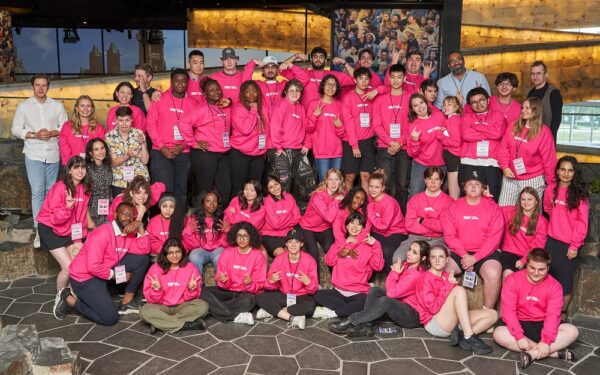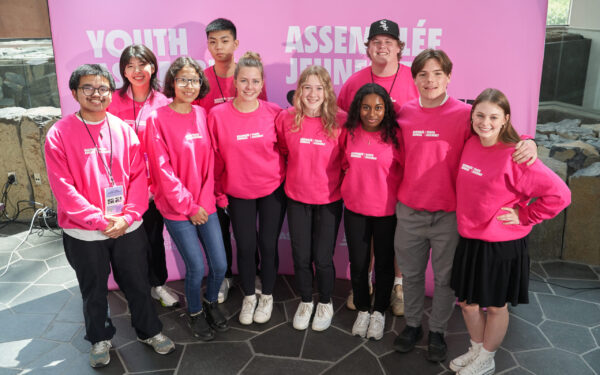Connected North brings different career paths to life for remote Indigenous students, by connecting them with experts through interactive video sessions.
Imagine the first-ever female Indigenous astrophysicist speaking virtually to your remote high school classroom, talking about a job or career you had never considered. Or maybe it’s a professional chef who lets you ask all of your burning questions about how they got started in the industry.
Connected North is a program led by TakingITGlobal that brings interactive educational sessions to schools in remote Indigenous communities through high definition, two-way video technology donated by Cisco. Their Future Pathways program connects students with Indigenous role models through remote schools in their Connected North network.
Students can learn live from experts across different career fields, from a medical illustrator to writers and musicians. The experience is almost like having a conversation with a guidance counselor, but better, because the program puts students in direct contact with people working in their field.
The Connected North program has grown to serve 100 schools across Canada, including all Nunavut schools, and many others across the territories and northern communities.

Cultural sensitivity is core to the program’s success. Lauren Butler, Manager of Communications and Fundraising at TakingITGlobal says Connected North works in communities that confirm their interest and reach out after learning of the project, largely through word of mouth.
They are a needs-based operation that considers the local context when helping coordinate interactive sessions. They work with teachers to ensure the content is engaging, tied to curriculum, and meets the educational needs identified by the local community.
Getting past the obstacle of limited connectivity in the North
CIRA has supported Connected North through our Community Investment Program grants initiative. The funding has helped the organization expand its content library by adding more virtual experts and field trips to their programming.
Given the serious connectivity challenges facing northern communities, CIRA’s funding is also used to produce and distribute copies of Connected North’s print catalog of sessions – a key resource for reaching remote communities with limited internet access.
Even where broadband connectivity fares better, printed materials and session catalogues are essential components of the program. Connected North ships printed materials to teachers to help make the digital project fully accessible, which Butler said is often not well understood.
“It’s not only live sessions. We send out materials, discussion guides, and whatever is needed for the lesson – whether it’s squid for dissections, children’s books by Indigenous authors, or packages of art supplies – we try to make it as interactive as possible. Classrooms speak with experts, but teachers often do parallel in-class teaching as part of the delivery,” she said.
1
The COVID-19 pandemic has highlighted how important high-quality internet connectivity is to learning, working and connecting with others. Data from CIRA’s Internet Performance Test shows that Canada’s massive urban-rural digital divide has actually grown since the onset of the pandemic in March.
While most kids are back in classrooms, many of the remote communities Connected North works with are still stuck with slow internet. This fall, Connected North will be awarding nearly 500 laptops and tablets to high school students from dozens of Connected North communities to address the digital inclusion challenges being faced.

TakingITGlobal’s Director of Innovation Michael Furdyk explains that “to overcome bandwidth limitations, the devices will be loaded with over 100 GB of pre-recorded Connected North content, video interviews with over 100 First Nations, Métis and Inuit role models, and digital skills training tutorials.”
The gaps in funding for digital literacy
The folks behind Connected North will be the first to tell you that they can’t do their job without sustained financial support — and they are not alone. In October, CIRA released a landmark study detailing the funding shortfalls facing organizations working on community-level digital development projects in Canada.
The key takeaway from the report is that while there is a vibrant charity sector working to improve Canadians lives through internet access and education projects like Connected North, the sector is critically underfunded, as Canada has no real tradition of “digital philanthropy.”
With projects like Connected North growing every year, Butler said she hopes that core funding for organizations working on digital development projects becomes a reality. Like many of the community organizations, we heard from through our digital funding research, Connected North relies on project-based funding for a large part of their work. Butler says they use a “jigsaw puzzle” approach, matching funder interests in specific types of content or particular regions to needs in the communities that Connected North serves. At CIRA, we hope that new funders will step up to support initiatives like Connected North, and provide core funding that will empower organizations achieve their long-term vision and goals.
CIRA is proud to support important projects like Connected North. Digital literacy is one of four funding areas in our flagship Community Investment Program grants program, which funds $1.25 million every year to support digital projects building a trusted internet for Canadians. Learn more about the program here.
Erica works in corporate communications at CIRA. Her background is in writing and community relations in the non-profit sector. She is a graduate of Carleton University’s journalism program.





